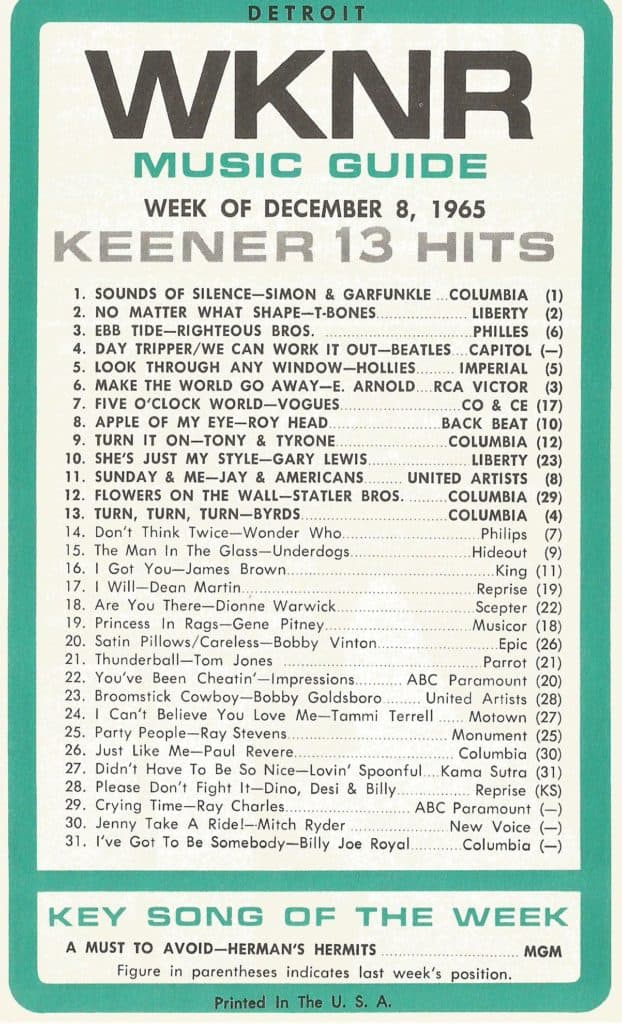 In December of 1965, the Vietnam war was raging in Southeast Asia. St. Louis residents were still marveling at the recently completed Gateway Arch. Pillsbury introduced a new spokesman, someone they called the doughboy. We were still humming Beatle tunes from their film, Help!, in the wake of their 4th and final appearance on the Ed Sullivan Show. The Detroit Red Wings were just under 500 on the season, hoping to extend a 4 game winning streak as they prepared to host the New York Rangers at Olympia Stadium. We were driving cars with maize and blue Michigan license plates, watching Divorce Italian Style on the Channel 7 late movie, and on CBS, promos were running for the Saturday night debut of “A Charlie Brown Christmas”.
In December of 1965, the Vietnam war was raging in Southeast Asia. St. Louis residents were still marveling at the recently completed Gateway Arch. Pillsbury introduced a new spokesman, someone they called the doughboy. We were still humming Beatle tunes from their film, Help!, in the wake of their 4th and final appearance on the Ed Sullivan Show. The Detroit Red Wings were just under 500 on the season, hoping to extend a 4 game winning streak as they prepared to host the New York Rangers at Olympia Stadium. We were driving cars with maize and blue Michigan license plates, watching Divorce Italian Style on the Channel 7 late movie, and on CBS, promos were running for the Saturday night debut of “A Charlie Brown Christmas”.
Keener’s playlist reflected the eclectic tastes of a public that was still processing the evolution of rock and roll. Eddie Arnold and the Statler Brothers shared the field with Simon and Garfunkle, The Hollies and the Byrds. The British Invasion was in full swing with 4 acts in competition for ear time. The Underdogs were one of the Michigan garage bands who were seeking a second chart hit, while playing with the likes of Suzy Quatro and a Doug Brown and The Omens at Punch Andrews’s Hideout Night Clubs, the latter featuring a keyboard player from Ann Arbor by the name of Bob Seger. Toys like the Easy Bake Oven, GI Joe and Whamo’s Superball were among the most requested Christmas gifts. Advertisements for David Lean’s Dr. Zhivago were appearing in Detroit area newspapers. The film would open on December 22, joining The Greatest Story Ever Told and The Sound of Music as the year’s biggest blockbusters.
On the WKNR Music Guide, the number 1 song was Columbia Records’ reinvention from Simon and Garfunkle’s Wednesday Morning, 3AM LP. The Sounds of Silence had flopped a year earlier, inspiring producer Tom Wilson to bring bassist Joe Mack, drummer Buddy Salzman and guitarists Vinnie Bell and Al Gorgoni into the studio to overdub an electrified backing track. Done without the duo’s knowledge, this gave the record a competitive edge in a field filled with electric competition.
The Beatles’ Day Tripper & We Can Work It Out, became one of the station’s highest debuting double sides, opening at number 4. Power rotation also included iconic hits like the Hollies’ Look Through Any Window, James Brown’s signature I Got You and the Vogues ode to the working man, 5 O’clock World. The James Bond film Thunderball was still in circulation at neighborhood theiaters, along with Tom Jones’ theme song. And The Lovin Spoonful’s follow up to Do You Believe in Magic, You Didn’t Have to Be So Nice, was in it’s second week on the charts.

Keener was in it’s prime as a Detroit radio brand, as is showcased in this classic Bob Green aircheck. The Letter from Santa contest distributed Kodak’s Instamatic cameras across the Motor City. Lucky license numbers and The Keener Word of the day were perennial promotions. Bob’s conversational energy is both engaging and infectious, reflecting the Intelligent Flexibility maxim that was at the key ingredient Keener’s secret sauce. You can hear other familiar voices, including Paul Cannon and Ted Clark and classic Detroit advertisers are in evidence, including Gene Merollis Chevrolet. Behind it all is the classic WKNR reverb, crafted from a Hammond Organ spring by chief engineer, Jerry Martin.
Listening again to the Keener sound reminds us that, then as now, communications is about building relationships. We are engaged to the extent that we feel part of the magic. And in the mid 1960s few things were more engaging than WKNR.

